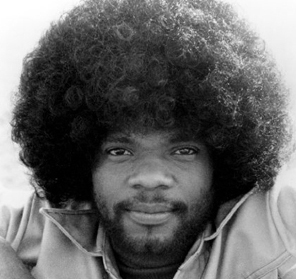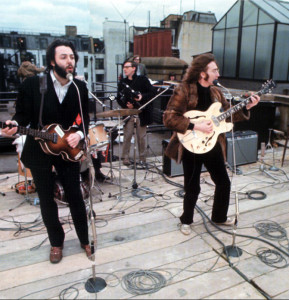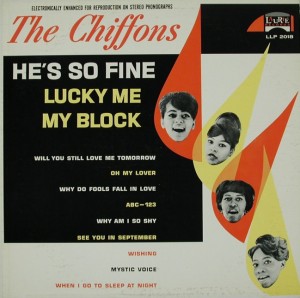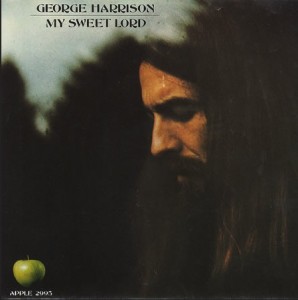That’s the way George Harrison sarcastically responded to Paul McCartney’s request that he alter his style of playing on “Two of Us,” a song recorded during the tension-filled sessions that would eventually spawn the “Let it Be” album and accompanying documentary. The exchange was captured for eternity, on 35mm film.
 George had simply had enough. Ever since joining the band at age 15, the “quiet one” had felt under-appreciated by the group’s high-profile hit-writers, Lennon and McCartney. Their songs were always given top priority on albums…always chosen for release as singles. George once said, “You’d have to do 59 of Paul’s songs before he’d even listen to one of yours.” He was the youngest of the four, and, despite his superiority as lead guitarist, John and Paul would always perceive him as the kid they brought into the fold. There was a natural pecking order, and George toughed it out in his usual low-key manner as he and his mates churned out one chart-topper after another.
George had simply had enough. Ever since joining the band at age 15, the “quiet one” had felt under-appreciated by the group’s high-profile hit-writers, Lennon and McCartney. Their songs were always given top priority on albums…always chosen for release as singles. George once said, “You’d have to do 59 of Paul’s songs before he’d even listen to one of yours.” He was the youngest of the four, and, despite his superiority as lead guitarist, John and Paul would always perceive him as the kid they brought into the fold. There was a natural pecking order, and George toughed it out in his usual low-key manner as he and his mates churned out one chart-topper after another.
But by the time The Beatles entered their late period – following the groundbreaking success of the band’s “Sgt. Pepper” LP – relationships among all four members had become downright hostile. John was increasingly distracted by the twin forces of Yoko Ono and hard drugs, giving nitpicky Paul free reign to assume the role of absolute boss during studio sessions. The situation had become so tense that even the usually unflappable Ringo walked out in frustration during the recording of the “White Album” in 1968, planning not to return. Eleven months later, in the midst of what Paul referred to as the “Get Back” sessions, the situation had deteriorated. Following arguments with Paul, and heated exchanges with John that nearly resulted in fisticuffs, it was George’s turn to break free of the band.
 During one particularly tumultuous session, he left the studio and attended a Ray Charles concert in London. There, he ran into Billy Preston, who was playing organ in Ray’s band. The Beatles had become friendly with the talented keyboardist during their days playing the Hamburg club circuit, when Billy was touring with Little Richard’s group and the four rockers were honing their chops in the dingy bars of the city’s red-light district.
During one particularly tumultuous session, he left the studio and attended a Ray Charles concert in London. There, he ran into Billy Preston, who was playing organ in Ray’s band. The Beatles had become friendly with the talented keyboardist during their days playing the Hamburg club circuit, when Billy was touring with Little Richard’s group and the four rockers were honing their chops in the dingy bars of the city’s red-light district.
Probably on a whim, George asked Billy to join him and the other Beatles in the studio to take part in the recording of several songs that would eventually comprise the “Let it Be” album.
 Preston’s outstanding playing, coupled with his open, gregarious manner, not only enhanced the sessions musically, but cut the tension considerably. A guest was in the room – one they all loved and respected – and there would be no bickering in the presence of the perky piano man. Billy breathed new life into the final days of the project. “It was a struggle for [the Beatles],” he once said of the sessions. “They were kind of despondent. They had lost the joy of doing it all.”
Preston’s outstanding playing, coupled with his open, gregarious manner, not only enhanced the sessions musically, but cut the tension considerably. A guest was in the room – one they all loved and respected – and there would be no bickering in the presence of the perky piano man. Billy breathed new life into the final days of the project. “It was a struggle for [the Beatles],” he once said of the sessions. “They were kind of despondent. They had lost the joy of doing it all.”
Bringing Billy to the scene was a brilliant move on George’s part. Had he considered the keyboardist’s stabilizing effect when he first recruited him for the gig? Probably not. But it did the trick, and allowed the boys to get through the remainder of the sessions in relative harmony. Billy joined the band in their last-ever public performance – the famous impromptu rooftop concert that caps the “Let it Be” film. Seated at his electric piano on that blustery day in January of 1970, he was a totally integrated member of the group. His jazzy piano solo during the song “Get Back” even earned him a credit on the single: “The Beatles with Billy Preston.” Various musicians had played on the band’s releases through the years, most notably Eric Clapton, who turned “While My Guitar Gently Weeps” into an instant classic, but Preston has the distinction of being the only artist ever given a written credit on a Beatles record.
 Billy later played on several songs issued on the band’s final album, “Abbey Road”: “I Want You (She’s So Heavy)” and “Something.” They signed him to their Apple Records label, and he worked on the solo releases of George, Ringo, and John following the breakup. But he was especially close and musically connected to “the spiritual Beatle” throughout their lifetimes (George died on November 29, 2001; Billy on June 6, 2006).
Billy later played on several songs issued on the band’s final album, “Abbey Road”: “I Want You (She’s So Heavy)” and “Something.” They signed him to their Apple Records label, and he worked on the solo releases of George, Ringo, and John following the breakup. But he was especially close and musically connected to “the spiritual Beatle” throughout their lifetimes (George died on November 29, 2001; Billy on June 6, 2006).
Mr. Preston once told the Chicago Sun-Times that his all-time favorite musical memory was playing “on the roof for Let It Be.” We have George to thank for that…and so much more. But I’ll save it for another article.
Here’s a clip of the now-famous exchange between George and Paul:
This is the trailer for the George Harrison documentary that Martin Scorsese produced for HBO a few years back.
© Dana Spiardi, Feb 25, 2014
]]>
 “He’s So Fine” was written by Ronald Mack, manager of the girl group. Of course George was familiar with the 1963 pop tune when he wrote his masterpiece. In his book I Me Mine he stated, “why didn’t I realise?” when friends began pointing out the similarities between the two songs. Oh, what’s a million bucks to a rock superstar, you might say. Well, remember – George was The Sensitive Beatle. The overly-harsh verdict shook him to the core. He strived for a life of peace and harmony, but couldn’t resist venting his frustration on vinyl – in the form of a biting piano-sax boogie called “This Song.” It appeared on his sixth studio LP, “Thirty Three & 1/3,” released in November 1976.
“He’s So Fine” was written by Ronald Mack, manager of the girl group. Of course George was familiar with the 1963 pop tune when he wrote his masterpiece. In his book I Me Mine he stated, “why didn’t I realise?” when friends began pointing out the similarities between the two songs. Oh, what’s a million bucks to a rock superstar, you might say. Well, remember – George was The Sensitive Beatle. The overly-harsh verdict shook him to the core. He strived for a life of peace and harmony, but couldn’t resist venting his frustration on vinyl – in the form of a biting piano-sax boogie called “This Song.” It appeared on his sixth studio LP, “Thirty Three & 1/3,” released in November 1976.
 This rollicking tune – featuring former Beatles’ sideman Billy Preston on keyboards and Monty Python’s Eric Idle on silly background vocals – unabashedly took aim at the lawsuit. Of particular note is the lyrical reference to Bright Tunes: this tune has nothing bright about it. In reality, “This Song” is the bright spot on a B+ album that peaked at #11 on the U.S. charts.
This rollicking tune – featuring former Beatles’ sideman Billy Preston on keyboards and Monty Python’s Eric Idle on silly background vocals – unabashedly took aim at the lawsuit. Of particular note is the lyrical reference to Bright Tunes: this tune has nothing bright about it. In reality, “This Song” is the bright spot on a B+ album that peaked at #11 on the U.S. charts.
George came to terms with his resentment fairly quickly. In 1979 he told long-time Beatles’ insider Derek Taylor, “I don’t feel guilty or bad about it, in fact [‘My Sweet Lord’] saved many a heroin addict’s life. I know the motive behind writing the song in the first place and its effect far exceeded the legal hassle.”
There you go. The spiritual Beatle ended up taking the high road. But I’m glad he took the low road long enough to produce the brilliant, oh-so-British music video of “This Song.” It blew us all away when it aired on Saturday Night Live in November 1976. Well done, George. Well done.
Here’s gorgeous George, guilty as charged. Drummer Jim Keltner plays the judge and Rolling Stones’ guitarist Ronnie Wood (in drag, with a blonde wig and wearing a big black hat) appears as a courtroom observer.
© Dana Spiardi, Feb 6, 2014
]]>